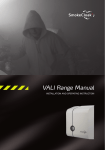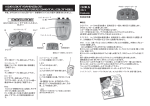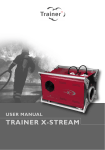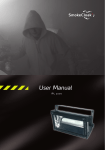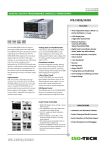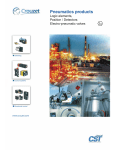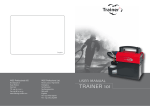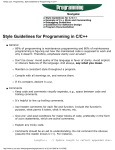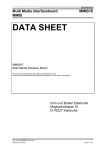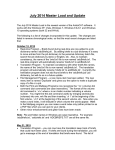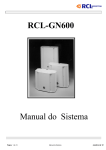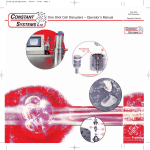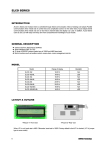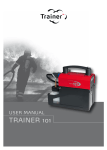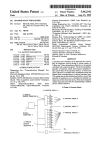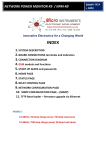Download User Manual - SmokeCloak
Transcript
User Manual SYSTEM 1 000 I 2000 I 4000 I 8 000 2 System 1000 I 2000 I 4000 I 8000 user manual Manual SYSTEM 1000 I 2000 I 4000 I 8000 Please read this manual carefully before attempting to install a Smokecloak system. Please hand the “End-User Guide” to your customer. 3 Conventions The following symbols are used in this manual to help you install the Smokecloak system correctly and safely. Gives useful advice or suggestions to enhance the performance of the Smokecloak system. Indicates important information that is critical for the correct use of your products and must always be read carefully. It is essential that only genuine Smokecloak fluid is used. Damage to the equipment and possible health hazard is likely if incorrect fluid is used. The warranty on all of the equipment will also be void. Under no circumstances should the on board power supplies of the Smokecloak (terminals 1, 6, 19, and 20) be linked to any other 3rd party equipment e.g. alarm panels, additional power supplies, etc. as this could cause unexpected faults within the machines. MSS Professional A/S Brunbjergvej 6 8240 Risskov Denmark Telefon+45 7217 0011 Fax +45 8617 0055 MSS Professional Ltd. Rectory Court, High Street Kislingbury Northampton Northants NN7 4AG England Phone +44 (0)1604 839000 Fax +44 (0)1604 832666 4 System 1000 I 2000 I 4000 I 8000 user manual Contents 1. SMOKECLOAK PARTS................................................4 Machine layout.......................................................4 2. SPECIFICATIONS.......................................................8 3. REQUIREMENTS......................................................10 4. INSTALLATION......................................................... 12 Mains Wiring........................................................ 12 5. MOUNTING.............................................................. 13 6. FLUID...................................................................... 21 Bottle positioning................................................. 22 7. BATTERIES.............................................................. 24 8. CLOAKSENSOR....................................................... 28 Cloaksensor wiring................................................ 30 9. CLOAK TIMING........................................................ 32 Cloak Timing switches........................................... 33 10. ALARM PANEL CONNECTIONS................................ 34 Connection examples............................................ 38 11. FAULT OUTPUTS..................................................... 40 12. VERIFICATION SENSOR...........................................44 13. FINAL TEST............................................................. 45 14. MAINTENANCE....................................................... 48 15. FAULT FINDING....................................................... 50 Flow chart........................................................... 50 16. EXAMPLES OF TYPICAL INSTALLATIONS.................. 54 17. ACCESSORIES......................................................... 58 18. NOTES.................................................................... 64 19. SMOKECLOAK INSTALLATION CHECK LIST................ 69 Contents 5 10 1 2 5 3 9 6 7 4 8 Smokecloak parts 6 1. Cover left side. 2. Fluid sensor. 3. Fluid FL600. 4. Pump(s). 5. Tamper protection. 6. Thermal trip. 7. Finger guard. 8. Output nozzle. 9. Front panel. 10. Mains. Smokecloak Parts 15 11 14 12 13 17 16 11. PCB. 12. Cable grips. 13. Loom Cable 20Way IDC. 14. PCB Smokecloak interface. 15. Cover right side. 16. Battery. 17. Battery cable. Smokecloak Parts 7 F5 F4 PL 9 PL PL PL PL 13 15 23 8 F2 PL 7 PL 17 PL 18 E PL 14 PL 12 PL 3 PL 4 F3 PL 1 PL 2 PL 22 PL 21 PL 20 PL 19 LD 1 SP 1 PL 16 PL 6 SW 2 SW 1 Main Board PL PL PL PL PL PL PL PL PL PL PL PL PL PL PL PL PL PL PL PL PL E 8 1 2 3 4 5 6 7 8 9 12 13 14 15 16 17 18 19 20 21 22 23 Connecters PL 5 Expansion port. IDE connector for interfaceboard Connector for fluidsensor - Low fluid Connector for fluidsensor - No fluid Connector for battery -. Connector for battery +. Low voltage transformer connection. Mains transformer connection (brown). Mains input Not connected. Not connected. Connector for heater (brown). Connector for heater (blue). Connector for pump(s) +. Connector for pump(s) -. Connector for pump(s) -. Thermal trip (white). Thermal trip (white). Thermo couple. Thermo couple. Mains transformer connection (blue). Chassis connection (PL 10). SW 1 SW2 F2 F3 F4 F5 LD 1 SP 1 Smokecloak Parts Switches Cloaktiming (see section on cloaktiming on page 32). Switch for future expansion. Fuses Transformer fuse output. Battery fuse. Heater fuse Transformer fuse input. Leds Heating system active. Audible System speaker. LD 9 PL 5 LD 10 PL 4 PL 3 PL 1 SW 1 PL 2 PL 7 LD 8 LD 7 LD 6 LD 5 LD 4 LD 3 LD 2 LD 1 Interface Board PL 1 Plug - in connectors PL 5 Connector for direct control of the Smoke-cloak - the Cloaksensor and Verification input. Main input from intruder alarm and optional fire alarm panel. Relay outputs for monitoring by the intruder alarm panel. Auxiliary 1 amp power supply, Optional mains fault output. Serial data port for future expansion. SW 1 Switches PL 2 PL 3 PL 4 1 Do not switch on 2 Do not switch on 3 Mains voltage failure (option) 4 Critical fault suppress when system set LD LD LD LD LD LD 1 2 3 4 5 6 LD 7 LD 8 LD 9 LD 10 Smokecloak Parts Leds Batteries OK Mains OK System Ready Heating system active Temperature control fault Low fluid OK Note: fault suppressed when system set No fluid OK System OK Note: SW1-4 will suppress this fault condition, if enabled, when set. Cloak timer active i.e. system triggered Backstoptimer (default)/Mains Supply OK (if SW1-3 and terminals 23-24 are used) 9 SY 1000 Dimensions 396 x 475 x 202 mm Weight 18.1kg Colour Beige Performance Fluid consumption Continuous run capability on 100 m3 in 30 sec all units (within the limits of the backstop timer) 180 m3 in 60 sec 0.45 cc/m3 Power consumption at 240 V 1.25 KVA quiescent 118 watt Mounting Vertical or horizontal Fluid reservoir Solid-state fluid level detection. 1 litre Heat up from cold 15 - 20 minutes Timer Factory set to 15 minutes (dipswitch 8) Variable 1-25 minutes in two ranges Cloaksensor confirmation (dipswitches 1-7) Included as standard Latching verification input Power supply Fuses F1 F2 F3 F4 F5 Auxiliary output Temperature Included as standard Resetting thermal trip for external supply 20mm transformer O/P 20mm battery Heater 240 V Heater 110 V Antisurge 20mm transformer I/P Solid state heater control Thermocouple temperature sensing Case temperature Low voltage external heater power supply input Processor Pumps Switch mode 3.15A 5A 10A 1.25˝ 15A 1.25˝ 1A 12 V 1 amp max Yes Yes Max. 40° C Optional Yes CMOS 16C711 8 bit microcontroller high pressure oscillating piston (14 bar) One fitted 24 volts solidstate variable output IP 21 IK 06 10 Specifications SY 2000 SY 4000 SY 8000 396 x 475 x 202 mm 476 x 475 x 202 mm 576 x 475 x 202 mm 21.1kg 26 kg 32.5 kg Beige 155 m3 in 30 sec Beige Beige 255 m3 in 30 sec 400 m3 in 30 sec 310 m3 in 60 sec 0.45 cc/m3 510 m3 in 60 sec 0.45 cc/m3 800 m3 in 60 sec 0.45 cc/m3 1.5 KVA quiescent 96 watt 2.5 KVA quiescent 120 watt 2.5 KVA quiescent 128 watt Vertical or horizontal Vertical or horizontal Vertical or horizontal 1 litre 1 litre 2 x 1 litre 15 - 20 minutes 15 - 20 minutes 15 - 20 minutes Variable 1-25 minutes in two ranges Variable 1-25 minutes in two ranges Variable 1-25 minutes in two ranges Included as standard Included as standard Included as standard Included as standard Included as standard Included as standard Switch mode Switch mode Switch mode 3.15A 5A 15A 1.25˝ 15A 1.25˝ 1A 12 V 1 amp max 3.15A 5A 15A 1.25˝ 20A 1.25˝ 1A 12 V 1 amp max 3.15A 5A 15A 1.25˝ 20A 1.25˝ 1A 12 V 1 amp max Yes Yes Max. 40° C Optional Yes Yes Yes Max. 40° C Optional Yes Yes Yes Max. 40° C Optional Yes CMOS 16C711 8 bit microcontroller CMOS 16C711 8 bit microcontroller CMOS 16C711 8 bit microcontroller One fitted 24 volts solidstate variable output Twin pumps 24 volts solidstate variable output Twin pumps 24 volts solidstate variable output 21 21 21 06 06 06 Specifications 11 UK installations In the UK the installation must be carried out to conform with British Standard BS7939:1999 for the installation and maintenance of Smoke Security Devices. BS7939 installation requirements summary The installer should, prior to the installation liaise with the local fire authority to ensure that there are no local restrictions in force. The installation should only be conducted by trained personnel who have passed a written test. The Smokecloak should be configured so that it can only activate when the burglar alarm is set. The Smokecloak must not be configured to form a “man-trap” i.e. activate to cut off a means of escape. The Smokecloak should not be installed to cover escape routes and staircases of areas that are still occupied. Care should be given not to fog joint access areas of adjoining premises. In multi-occupancy buildings or in large sites with internally Smokecloak protected areas, the vapour must be confined to those areas and must not be allowed to infringe into public or open areas. Care must be given to automatic fire alarm systems so as not to cause unwanted or false activations. Consideration should be given to audible and visual indication of Smokecloak activation. 12 Requirements The installer should inform fire brigade, police and monitoring station of the installations prior to commissioning. A full test activation should be performed as part of the installation. For installation outside off the UK, please adher to local standards Warning signs must be displayed at the normal points of entry to the building. Requirements 13 This equipment should only be installed and connected to the supply by a suitably skilled and competent person. This apparatus must be earthed. Connections are made to a plug-in terminal block. The Smokecloak should be connected to a standard 13 amp fused spur. Flexible mains cables must have a minimum crosssection area of 1.25 mm2 (and must be BASEC approved in the UK). Ensure that the protective earth conductor is made longer than the line and neutral conductors, and that the cable clamp grips both the sheath and insulation. 220-240 volts mains is connected to the mains block connector. Smokecloak SY8000/4000 draws 2.5Kw (11 amps), SY2000 draws 1.5Kw (7.5 amps) and SY1000 draws 1.25Kw (5.2 amps) when initially heating up, or producing vapour. It is important that connections are properly made. 14 Mains Wiring • The Smokecloak can be vertically or horizontally mounted. a b • The Smokecloak has two mounting areas: a) a removable top mounting bracket and b) a lower fixed security mounting. Mounting 15 (8 screws SY1000-2000, 10 screws SY4000-8000). • Prior to mounting the Smokecloak the side covers should be removed by undoing the screws indicated. • Remove both side covers from the Smokecloak. 16 Mounting • Remove the top mounting bracket. Mounting 17 Min 10 c m The integral removable bracket is designed to be mounted to a solid surface using suitable fixings. To mount a machine horizontally, use 6 mm threaded rod into four of the mounting holes in the Smokecloak. The rods must be secured to support the machine safely. Ensure the machine is no more than 3 m above the floor, otherwise smoke dispersal may be compromised. Leave sufficient room (at least 10 cm) above and around the Smokecloak or it will not be possible to remove/fit the securing bolts and case screws. It is not recommended to install the machine in excess of 2.5m high, otherwise the smoke coverage near the floor may be compromised. The output nozzle may be adjusted, to aim the jet down, by removing the safety grill and bending the pipe. Be careful as the nozzle is extremely hot (300 degrees centigrade). Also do not crush ro kink the pipe. An angle of approximately 30 degrees can be achived. 18 Mounting High voltage Low voltage • Route cables from the alarm panel, the verification movement detector (if fitted) and Cloaksensor to the centre of the bracket and clamp off using the cable grips provided. The mains power and low voltage control signals are clamped to this bracket using the cable clamps provided. The cables should be routed from the centre of the bracket through the cable clamps are then terminated with the supplied plugs. Lead lengths between the clamps and plugs should be a minimum of 30cm. Use the correct cable entry points on the bracket or the fitment of the side panels will not be possible. Mounting 19 • Mount Smokecloak on bracket. With the panels removed it is possible to fit the Smokecloak onto the bracket - it drops on to locate, the bracket supports the weight of the Smokecloak while the lower fixings are secured. Route the cables through the provided channels to each side of the machine. The lower fixed bracket provides a tamperprotected mounting. If the machine is mounted horizontally it will require at least two people to lift it into position and attach it to the mountings. 20 Mounting • Refit the two top securing bolts. •The lower security bracket can now be fixed to the wall. Mounting 21 Chassis earth connection Mains plug • Remove the mains plug from the left-hand side of the motherboard and fit to the flexible mains cable, plug mains lead into motherboard and refit fuse in spur. Observe connection polarity. • Listen for power up confirmation tone. 22 Mounting FL600 fluid is used to generate the vapour cloud. This glycol fluid is made to a special formula, which is designed to produce 40% obscuration of light at 40 cm with minimum condensation. It is essential that only genuine Smokecloak fluid is used. Damage to the equipment and possible health hazard is likely if incorrect fluid is used. The warranty on all of the equipment will also be void. The bottle should be installed in the left-hand compartment, insert both the pipe(s) and fluid sensors into the bottle and push the supplied lid into the bottle - the Smokecloak will not function if it cannot detect sufficient fluid. Remove red transport seals from the end of the fluid pipes Ensure that the pipes nearly reach the bottom of the bottle, if the unit is being mounted horizontally tie-wrap the pipes to the bottle handle to ensure correct positioning. The fluid should be changed (not topped up) at least once a year, and must be changed at a maximum, of 18 months. Do not mix batches of fluid. (Batch number is printed on the front of the bottle). Remove red transport seal from the fluid sensor assembly. Otherwise the machine will not function. Fluid 23 Vertical mounting If the Smokecloak is mounted vertically the bottle is placed in the left hand compartment. Do not use the supplied metal bottle band in vertical mounting. 24 Fluid Horizontal mounting Metal bottle band If the Smokecloak is mounted horizontally the bottle is fixed using the supplied metal bottle band. To enable the side case to be refitted without kinking or damaging the pipes, a small section of the metalwork will have to be removed. This should be large enough to allow the pipes and cables to protrude without interference. Remove all sharp edges from the modified metalwork. Fluid 25 The battery backup system provides power for the control electronics and pumps when mains electricity is removed. It is necessary that batteries are installed for correct operation. The batteries are inserted into the right hand compartment and connected in series using the supplied link wire. They are clamped to the chassis using the supplied reusable straps. The standard backup system does not provide power for the heater. The insulation is designed to retain sufficient heat in the aluminium heat exchanger assembly. The Smokecloak must have the batteries installed, even when operating from the mains, in order to operate the pumps at correct performance. The battery backup system requires 24 volts DC - it is necessary to fit two 12 volt 2.0 – 2.4 Ah batteries in series in the Smokecloak. Do not use larger than 2.4Ah capacity batteries to prevent fuse failure due to excessive charging current. Please note that the temperature inside the Smokecloak can exceed 40 degrees depending on the ambient temperature and that the batteries must be able to withstand temperature under charging. 26 Batteries Take care with polarity. The Smokecloak is protected with fuse (F3) which will blow if the system is reverse polarity connected. The LEDs on the interface board will give indication of correctly installed fluid and batteries. PCB damage due to incorrectly fitted/sized batteries is not covered under warranty. Red + Black Black - 12 Vo lt s, 2 . 1A h Red + The jump wire that links the two terminals on the right of the batteries is a blue wire. Batteries 27 Black Red + Black - Reusable ties 28 Batteries Red + 29 The Cloaksensor detects and controls the amount of vapour produced by the Smokecloak. The Cloaksensor requires careful siting. Fit the sensor in a position in the room which will provide an indication of the drop in vapour concentration, (normally in the centre of the area the machine is protecting. Always test the system after installation to confirm the chosen position is correct) but also observing the following notes: Wall Mounting When a ceiling position is not practical (for example on a ceiling having exposed beams or joists or built-in radiant heating), put the top edge of the Cloaksensor between 30 and 60 cm (12 and 24 inches) below the ceiling. Keep at least 60cm (24 inches) from corners. On a sloping ceiling In areas with sloping or peaked ceilings install the Cloaksensor 90 cm (3 feet) from the highest point measured horizontally because the “dead air” at the apex may prevent smoke from reaching the unit. 30 Cloaksensor Locations to avoid Near a decorative object, door, light fitting, window moulding etc., that may prevent smoke from entering the Cloaksensor. Surfaces that are normally warmer or colder than the rest of the room (for example attic hatches, uninsulated exterior walls etc). Temperature differences might stop smoke from reaching the unit. Next to or directly above heaters or air conditioning vents, windows, wall vents etc. that can change the direction of airflow. Safeguards To maintain sensitivity to smoke, do not paint or cover the Cloaksensor in any manner and do not permit any accumulation of cobwebs, dust or grease. Cleaning The Cloaksensor must be cleaned at regular intervals. Cloaksensor 31 A 6-core lead is taken to the Cloaksensor for smoke density control from PL1 terminals 1, 3, 5 and 6. It is recommended that an extra pair is used as a tamper loop and simply returned in the Cloaksensor. Terminal 1 (12 volts) is taken to + (12 volts) of the Cloaksensor. Terminal 3 (Cloaksensor) is taken to NO (normally open) of the Cloaksensor. Terminal 5 (Signal 0 volts) is taken to C (common) of the Cloaksensor. Terminal 6 (0 volts) is taken to - (0 volts) of the Cloaksensor. Smokecloak interfaceboard 1 3 5 6 1 4 2 3 Cloak sensor 32 Cloaksensor 33 Dipswitches 1-6 on the right of the motherboard set the initial fill time. Dipswitch 7 doubles the times – normally leave off. Dipswitch 8 changes the backstop timer setting to 2 minutes – normally leave off. To determine the required setting flip all six switches on, then carry out a test firing and note the time required to fill the room or set the dipswitches using the time chart below. Avoid overfilling the room – visibility should be reduced to approx. arms length. Example System 4000 in a room of 250m3, due to the layout of room sufficient vapour was generated after 30 seconds. Switches 1-2-3 were switched on. When Smokecloaks are installed horizontal with the vapour jet aimed down it will take longer for the vapour to disperse throughout the room. Avoid setting the fill time for too long otherwise localised high concentrations will be produced, and always take into account the volume of the area that requires protection. Approximate fill volumes in m3 as a guide by time: 34 Model SY 1000 SY 2000 SY 4000 SY 8000 30 seconds 100 155 255 400 60 seconds 180 310 510 800 90 seconds 220 380 630 1200 120 seconds 250 450 750 1400 Cloak Timing Software v. 1.x 1 2 ON 3 4 5 6 7 1 2 ON 3 3 4 5 6 7 5 8 1 2 ON 3 8 4 3 4 5 6 7 1 2 ON 3 3 4 5 6 7 8 1 2 ON 3 8 8 5 6 7 8 4 4 5 6 7 8 1 2 ON 3 4 5 6 7 8 1 2 ON 3 3 4 5 6 7 8 6 7 8 4 5 6 7 8 50 Seconds 1 2 ON 3 4 5 6 7 8 80 Seconds 1 2 ON 3 100 Seconds 1 2 ON 5 20 Seconds 70 Seconds 90 Seconds 1 2 ON 7 40 Seconds 60 Seconds 1 2 ON 6 10 Seconds 30 Seconds 1 2 ON 4 4 5 6 7 8 110 Seconds 1 2 ON 3 4 5 6 7 8 120 Seconds 180 Seconds 220 Seconds 10 Seconds 45 Seconds 90 Seconds 15 Seconds 50 Seconds 95 Seconds 20 Seconds 55 Seconds 100 Seconds 25 Seconds 60 Seconds 105 Seconds 30 Seconds 65 Seconds 110 Seconds 35 Seconds 80 Seconds 115 Seconds 40 Seconds 85 Seconds Software v. 2.x 35 To use 23/24 mains failure, sw1/3 must be set to on. PL 1 Terminal Terminal Terminal Terminal Terminal Terminal 1 2 3 4 5 6 12 Volts PIR Cloaksensor Not used Signal 0 Volts 0 Volts PL 2 Terminal Terminal Terminal Terminal Terminal Terminal 7 8 9 10 11 12 Fire inhibit + Fire inhibit Set + Set Smoke + Smoke - PL 3 Terminal Terminal Terminal Terminal Terminal Terminal 13 14 15 16 17 18 Normally open System active Normally closed (open in fault condition) Low fluid Normally closed (open in fault condition) System fault PL 4 Terminal Terminal Terminal Terminal Terminal Terminal 19 20 21 22 23 24 12 Volts out + (1A Max) 12 Volts out - (1A Max) Not used Not used Normally open AUX OUT Backstop timer (default) / Mains failure PL 5 SW 1 Dataport Option Option Option Option switch switch switch switch 1 2 3 4 Do not use Do not use Mains failure output Fault output suppress Under no circumstances should the on board power supplies of the Smokecloak (terminals 1, 6, 19, and 20) be linked to any other 3rd party equipment e.g. alarm panels, additional power supplies, etc. as this could cause unexpected faults within the machines. 36 Alarm panel connections SW 1 PL 4 24 23 22 21 20 19 PL 3 18 17 1 2 34 16 15 14 LEDS 13 LD 8 LD 10 LD 7 LD 9 LD 6 PL 2 12 PL 5 LD 5 11 LD 4 10 9 LD 3 8 LD 2 7 LD 1 1 2 3 4 5 6 PL1 LEDS LD LD LD LD LD LD LD LD LD LD 1 2 3 4 5 6 7 8 9 10 Battery (on - ok) Mains (on - ok) System ready (on - ready) Heater (on - heating) Temperature fault (on - fault) Low fluid (on ok, off fault) No fluid (on ok, off fault) System (on - ok) System active (on - active) Backstop active (on - active) Alarm panel connections 37 Connections between the Smokecloak and the alarm panel are made to the interface board via four 6-way plug-in connectors. 10 LEDs also found on the interface board indicate information concerning the status of the Smokecloak. The inputs to the Smokecloak are optoisolated and can be directly connected to transistorised outputs from alarm panels (2mA draw), the connections are polarity conscious and care should be taken. The fault outputs are “clean” 150mA, 60v DC solid state relay contacts PL3 and PL4 (terminals 13-18, 23-24). During the day when the alarm panel is de-activated, it is important that Smokecloak cannot produce smoke, so the pump(s) are only connected to the control electronics when the panel is set or armed. Cables required: 1 cable with 16 cores - 1 pair for critical fault - 1 pair for tamper - 1 pair for low fluid - 1 pair for set 38 - 1 pair for trigger Optional: - 1 pair for fire alarm inhibit - 1 pair for Smokecloak active Alarm panel connections The four inputs to the Smokecloak are optoisolated and can be directly connected to transistorised outputs from alarm panels (2 ma draw), the connections are polarity conscious and care should taken (PL2 terminals 7-12). The inputs to the Smokecloak require between 5v – 12v applied to operate correctly (normal power supply tolerances apply). They will draw approx 2 ma from the alarm panel. Under no circumstances should the on board power supplies of the Smokecloak (terminals 1, 6, 19, and 20) be linked to any other 3rd party equipment e.g. alarm panels, additional power supplies, etc. as this could cause unexpected faults within the machines. Alarm panel connections 39 Use the appropriate diagram below to interface the Smokecloak to your panel. Positive set and positive trigger: Smokecloak interfaceboard Alarm panel 12v 12 11 10 9 o/p +set o/p +alarm 0v Negative set and negative trigger: Smokecloak interfaceboard Alarm panel 12v 12 11 10 9 o/p -set o/p -alarm 0v Smokecloak does not latch; as soon as either of these signals are removed, vapour production stops. Disclaimer: Actual alarmpanels may vary from the illustrated and MSS Professional can not be held responsible for faults due to incorrect installation. 40 Alarm panel connections Use the appropriate diagram below to interface the Smokecloak to your panel. Positive set and negative trigger: Smokecloak interfaceboard Alarm panel 12v 12 11 10 9 o/p +set o/p -alarm 0v Negative set and positive trigger: Smokecloak interfaceboard Alarm panel 12v 12 11 10 9 o/p -set o/p +alarm 0v Smokecloak does not latch; as soon as either of these signals are removed, vapour production stops. Disclaimer: Actual alarmpanels may vary from the illustrated and MSS Professional can not be held responsible for faults due to incorrect installation. Alarm panel connections 41 Smokecloak has two outputs that feed fault information back to the alarm panel. Low fluid output Terminals 15 and 16 are normally closed. These open if the bottle is less than half full. This output is always suppressed when the system is set. Critical fault output Terminals 17 and 18 are normally closed. These open if a critical fault is present (loss of mains power, faulty batteries, no fluid or temperature fault). This output can be suppressed when the Smokecloak is SET by switching switch SW1-4 on. Mains failure can be monitored separately by setting sw1-3 to on and connecting terminals 23 and 24 to a zone on the alarm panel. It is essential that these fault circuits should only be connected to either a logged local warning circuit (i.e. technical or plant monitor) or via the communicator to the central station, so that, in the event of a fault, a full alarm condition will not occur! It is not desirable to have a full alarm condition and then a Smokecloak activation just because of a fault condition. If the alarm panel is not capable of supporting local alarm only, for monitoring these circuits, then consider using a spare communicator line to central station. As a last resort a buzzer or LED can be used as a warning device. If in doubt please contact MSS Professional for advice. 42 Fault Outputs 43 Fault circuit connections at panel. Smokecloak interfaceboard Alarm panel 18 17 16 15 Zones configured as fault detection inputs - must not produce full alarm condition. Disclaimer: Actual alarmpanels may vary from the illustrated and MSS Professional can not be held responsible for faults due to incorrect installation. 44 Alarm panel connections Demo/test button wiring Smokecloak interfaceboard 20 19 12 11 10 9 Demo button Smokecloak does not latch; as soon as either of these signals are removed, vapour production stops. Alarm panel connections 45 A normally closed loop provided by door contacts, PIRs or similar can be connected to terminals 2 and 5, the power for active devices (250mA max) is taken from terminal 1 (+12 volts) and terminal 6 (0 volts). This input does not trigger the Smokecloak, but holds off its activation despite an alarm trigger until the verification loop detects an intruder. The backstop timer is also inhibited until smoke is produced. Smokecloak interfaceboard 56 + NC C - 1 2 Verification sensor 46 Verification sensor (optional) Before producing any smoke it is essential that the local fire brigade, people on site and neighbours are informed of what is going to happen. Ensure that any fire detection system is put on test or the customer has control of it. Smokecloak will activate all types of smoke detector. However, it will not activate heat or carbon monoxide detectors. The supplied Smokecloak warning signs must be fitted on or near likely points of entry. This is an insurance requirement to warn any person entering the building that Smokecloak is installed. The output nozzle may be adjusted, to aim the jet down, by removing the safety grill and bending the pipe. Be careful as the nozzle is extremely hot (300 degrees centigrade). Also do not crush ro kink the pipe. An angle of approximately 30 degrees can be achived. Please ensure the End User guide is handed to the customer. Final test 47 Fully test the system by: • Arming the alarm system. The Smokecloaks will produce a 3 second tone. • Activating the alarm as an intruder would. •If verification sensors are connected you will need to trip them (these are optional and may not always be fitted). •The Smokecloak(s) should now start to activate. They will continue until the Cloaktimer times out, or the alarm is disarmed. During this smoke production period the Smokecloak(s) should produce a double tone. This shows the Cloaksensor has received sufficient smoke. •When all of the machines have stopped producing smoke, disarm the alarm panel. •Check that there is sufficient smoke for protection of the premises, i.e. visibility reduced to arms length. •Now vent the smoke using doors and windows to create a through draught. Observe the amount of smoke exiting the building at any one time so not to cause inconvenience to other people or attract unnecessary attention. It is useful to have people at the venting points to let passers by know what is happening. •Check the fluid in each machine, as appropriate. This is to ensure that there is enough to protect the site on future activations. • Refit side covers on machines. 48 Final test • Refit side covers. To prevent fire or shock hazard, do not expose this appliance to rain or moisture. Final test 49 Smokecloak machines require an annual maintenance. This requires the following: •A full test of the system as per section 13 (final test, page 45-47). •Replace the fluid (do not top the fluid up). •Load test the batteries and replace as necessary. It is recommended that batteries are replaced every 2 years due to the heat inside the machine. Check LEDs are correct as per following table. 50 Maintenance PL 4 SW 1 24 23 22 21 20 19 PL 3 18 17 1 2 34 16 15 14 LEDS 13 LD 8 LD 10 LD 7 LD 9 LD 6 PL 2 12 PL 5 LD 5 11 10 LD 4 9 LD 3 8 LD 2 7 LD 1 1 2 3 4 5 6 PL1 LEDS LD LD LD LD LD LD LD LD LD LD 1 2 3 4 5 6 7 8 9 10 Battery (on - ok) Mains (on - ok) System ready (on - ready) Heater (on - heating) Temperature fault (on - fault) Low fluid (on ok, off fault) No fluid (on ok, off fault) System (on - ok) System active (on - active) Backstop active (on - active) Maintenance 51 Remove the two side covers. 1. Check fluid sensors. if not the solid tube type with integral bottle bung, Go to A. A: Call MSS Professional technical support suspect exchange part required. B: Call MSS Professional technical support for advice. 5. Ensure red LED 4 is not lit then carry out brief test firing of Smokecloak. 4. Arm pumping system by setting alarm system. listen for the 2 second tone produced by the Smokecloak if non, if no smoke produced, Go to B. Go to A. 8. Check Smokecloak fault circuits are not connected to the tamper or full alarm circuit of the alarm panel. 9. Check fault circuits of Smokecloak (terminals 15-16, 17-18) are connected to technical type monitoring zones of alarm panel. Important NOT 24 hour zones or standard zones as these will produce a full alarm condition on fault. 52 Fault finding 2. Check the temperature of the Smokecloak cabinet, if it is cold check: if yellow LED 5 is lit, 3. If unit is warm check that green LED 3 is on. if it is then continue otherwise, Go to B. Go to A. if red LED 4 is lit, and has been for more than 25 min, Go to B. 6. Check red LED in the centre of Cloaksensor flashes every 7 seconds. if not, Go to B. 10. IMPORTANT Check the batteries preferably with a battery load tester. 7. Carry out full test of system. note that the run time is set by the Cloaktimer dipswitches (between the battery connectors). Check that the time setting is appropriate for the volume of the room requiring protection. 11. Replace the old bottle of fluid with a new one. Refit case. Fault finding 53 54 System 1000 I 2000 I 4000 I 8000 user manual The following pages have some examples of typical installations 55 This company is a distributor of high value prestige products. The bulk of the premises is taken up with warehouse storage. There had been a number of attacks on the building, and the windows were heavily protected with bars. Each attack had required the burglars to use more and more force to gain entry as the physical protection was improved. Finally their alarm company suggested Smokecloak. 2 The warehouse is 10m wide by 10m long - an area of 100m . The average 3 ceiling height is 5m, which makes a total volume of 500m . 3 Two Smokecloak SY4000s (each produce 255m of vapour in 30 seconds) were mounted at 2,5 m height on the wall with the output angled down at approximately 20º. This is important, as the vapour is required at ground level, where the burglars are. 8 seconds following activation the vapour hits the opposite wall, and then returns towards the wall where Smokecloak is mounted. After 30 seconds the whole volume is filled. 56 Example 1: Prestige products distributor SY4000 m 10 10 m Main stock area Office area Cloaksensor Prestige products distributor stock. Example 1: Prestige products distributor 57 In 1998 this school had a repeating problem with computer theft from its IT classrooms. Good physical security precautions were in use; bars had been fitted to all the windows in the rooms and access control systems were fitted to all the doors. Despite this, the school suffered attacks every week. Losses were unsustainable, so the host alarm company suggested Smokecloak. 3 Most of the classrooms are 8m x 8m x 4m high - 256m . In these rooms a single Smokecloak SY4000 was mounted up high on the wall (approx 2.5 m) with the output again angled down. This kept the Smokecloaks away from the pupils, reducing the possibility of sabotage attempts. Verification was used to allow zoning of the protection, i.e. only activate in classrooms that were being attacked and in addition reduce the likelihood of false alarms. A combination of vibration detectors on the doors and a 360° movement detector on the ceiling was used to verify the intrusion. 3 The dimensions of the largest classroom were 18m x 8m x 4m - 576m . In order to provide suitable protection, two Smokecloaks were used. 3 A Smokecloak SY8000 (400m in 30 seconds) was mounted beside the door 3 into an adjoining classroom and an additional SY2000 (155m in 30 seconds) was mounted on the wall opposite the most likely point of entry. Again, vibration detectors on the doors and 360° movement detectors on the ceiling both inside and outside the room were used to verify the intrusion. A total of nine Smokecloaks have been installed; the school has not suffered any losses due to burglary since the installation in 1998. 58 Example 2: School in Nottinghamshire SY 8000 Cloaksensor 360 PIR 8m m 18 Desks with many computers SY 2000 School in Nottinghamshire Example 2: School in Nottinghamshire 59 Fluid FL600 Smokecloak FL600 is an exclusive mixture of demineralised water and food grade glycols. The formula that has been developed through many years of experience and R&D gives a unique combination of density and hang time. The Smokecloak FL 600 fluid is very economical in use and requires just 0.45cc. to produce a cubic metre of Smokecloak vapour. The typical “hang” time in a static air environment is around 45 minutes and the FL 600 fluid creates a uniform sub micron particle size Fluid is supplied in different sizes to suit the variety of machines and run times. The fluid is harmless and a full safety data sheet is available on request. Dimensions 1 Litre: 135 x 88 x 170 mm Dimensions 2.5 Litre: 150 x 120 x 230 mm 60 Weight 1 Litre: Weight 2.5 Litre: 1.1 kg 2.7 kg Colour: White Accessories Cloaksensor CS07 The Smokecloak CS07 cloaksensor is the part of the system that detects whether the room has the correct amount of vapour, and sends a signal to the Smokecloak machine requesting more vapour if the room is below the optimum level. The unit is build into a standard smoke detector case and the internal circuitry and calibration is specifically designed and constructed to meet the requirements of the Smokecloak system. Dimensions: 110 x 50 x 140 mm Weight: 0.167 kg Colour: White Accessories 61 Strobe IPL3000 The IPL 3000 is designed to provide Instant Protection combined with a reduced Smokecloak smoke density, to produce a blinding effect. The IPL 3000 is a high quality, very high intensity, security strobe light. The system is compatible with all of the Smokecloak products, and is configured so that the operation of the IPL 3000 is controlled by the Smokecloak. The IPL 3000 is designed for easy installation. The outer casing is made of metal, and has sabotage protection so it can be located in public areas or concealed in roof spaces if preferred. 62 Dimensions: 425 x 245 x 240 mm Weight: 7.5 kg Colour: Black Accessories Sounder IPA125 The patented sound of the IPA 125 is produced by 8 extremely powerful transducers driven by a custom built amplifier. This makes the IPA 125 capable of producing 125 db of intolerable sound at a distance of 1 metre. The built-in alarm interface makes it easy to connect to any electronic alarm installation and with on board battery back up, reliable protection is secured. The IPA 125 is designed to easily to fit into all types of buildings. The outer casing is made of aluminium, and incorporates sabotage protection. The IPA 125 can be easily linked with other IPA 125 units in order to protect a larger areas; the Smokecloak products can be used to control the IPA 125. Dimensions: 686 x 103 x 41 mm Weight: 1.7 kg Colour: Aluminium Accessories 63 Voice Module The Smokecloak CS140 voice module is a 12 volt digital voice system, containing an embedded chip with a pre-recorded message. It is designed to be remotely positioned near to the normal access to the building and, if required, the protected area. The unit is particularly important in large, multi-occupancy or public access buildings so that any innocent third party is clearly aware of what is happening and that they should leave the area. The standard voice module are available in English, German, French, Spanish and Portuguese although customised units are available to special order. 64 Dimensions: 195 x 118 mm Colour: Aluminium and gray Weight kg: 1.9 kg Accessories Batteries The Smokecloak is installed with two lead-acid batteries ensuring full smoke protection in the event of main power failure. The battery is from one of the worlds leading manufactures of maintenance-free lead acid batteries. This assures long service intervals, and low periodical costs. The battery is especially designed for the operational conditions in alarm systems, with long stand-by periods and short intense energy loads. Dimensions: 178 x 34 x 67 mm Weight kg: 0.90 Battery Type: NP2.1-12 Nominal Voltage V: 12 Capacity: 2.1 Ah Accessories 65 66 Notes Notes 67 68 Notes Smokecloak installation Check list Model Serial number 3 01. Volume of room width m length m height m m 02. Cloaksensor timing in seconds sec 03. Backstop timer setting if not 15 minutes (factory setting) min Yes No 05. Has Cloaksensor position been tested? (acknowledgement tone) Yes No 06. Fire alarm inhibit input used Yes No 04. Is PIR verification in use? If yes how many? 07. Inputs Set/Unset circle which used + switch 08. Inputs Trigger circle which used 09. Low fluid monitored 5V + switch - switch 12 V - switch 10. Critical fault monitored 5V 12 V 11. Tamper monitored Yes No 12. Batteries fitted Yes No 13. Date of commissioning Yes No 14. Engineer’s name Yes No Dated Signed This form should be completed and stored with the alarm panel documents Smokecloak installation Check list 69 Supplier: Januar 2010 Contact: MSS Professional A/S Brunbjergvej 6 DK - 8240 Risskov Phone +45 7217 0011 Fax +45 8617 0055 MSS Professional Ltd. Rectory Court High Street Kislingbury UK - Northants, NN7 4AG Phone +44 (o) 1604 839 000 Fax +44 (0) 1604 832 666 www.smokecloak.com







































































